Drawdown Solutions: Food's Impact on Climate Change in New Zealand
VerifiedAdded on 2023/04/20
|13
|3647
|236
Report
AI Summary
This report explores the impact of food production on climate change, examining the global and New Zealand perspectives. It highlights the contribution of land clearing, fertilizer use, and food processing to greenhouse gas emissions. The report discusses the Drawdown Project's solutions, such as reducing food waste, promoting plant-based diets, and improving agricultural practices. It then focuses on the specific situation in New Zealand, where agriculture poses a significant threat due to increasing land clearance and emissions. The report outlines practical measures being implemented in New Zealand, including controlled agriculture, reforestation, and regulated food processing, and suggests metrics to track progress, such as climate-smart investments and organized marketing of agricultural output, the aim is to mitigate the negative impacts of food production on the climate.
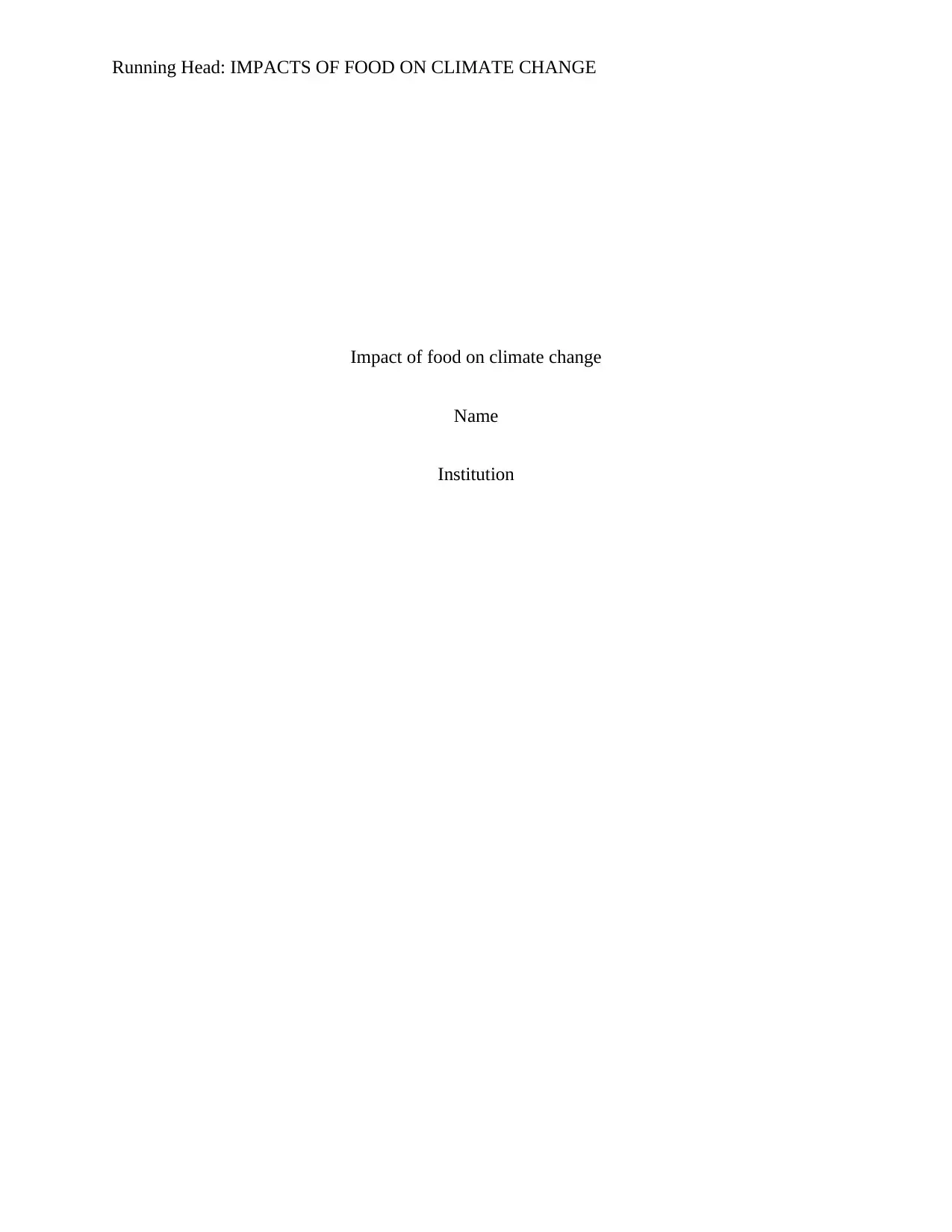
Running Head: IMPACTS OF FOOD ON CLIMATE CHANGE
Impact of food on climate change
Name
Institution
Impact of food on climate change
Name
Institution
Paraphrase This Document
Need a fresh take? Get an instant paraphrase of this document with our AI Paraphraser
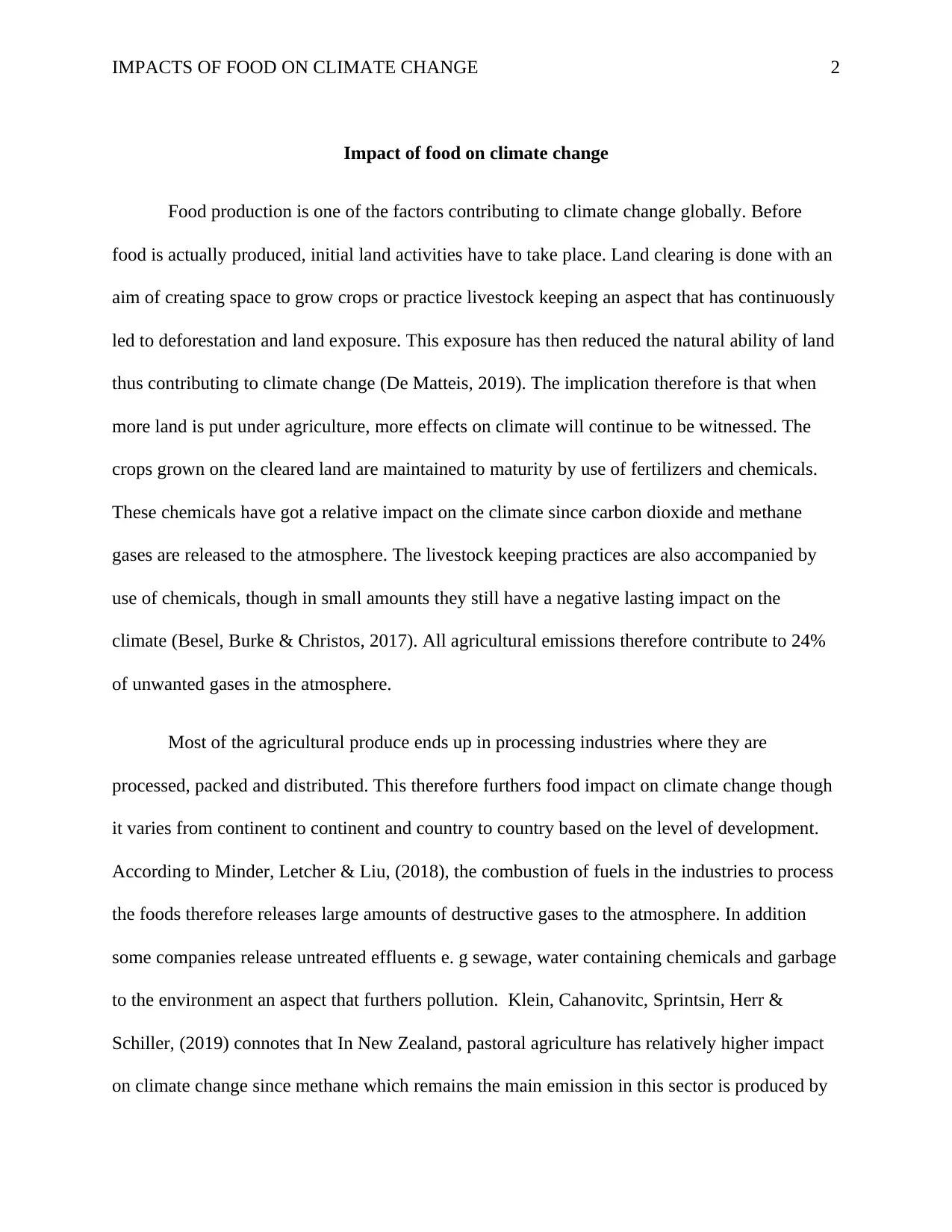
IMPACTS OF FOOD ON CLIMATE CHANGE 2
Impact of food on climate change
Food production is one of the factors contributing to climate change globally. Before
food is actually produced, initial land activities have to take place. Land clearing is done with an
aim of creating space to grow crops or practice livestock keeping an aspect that has continuously
led to deforestation and land exposure. This exposure has then reduced the natural ability of land
thus contributing to climate change (De Matteis, 2019). The implication therefore is that when
more land is put under agriculture, more effects on climate will continue to be witnessed. The
crops grown on the cleared land are maintained to maturity by use of fertilizers and chemicals.
These chemicals have got a relative impact on the climate since carbon dioxide and methane
gases are released to the atmosphere. The livestock keeping practices are also accompanied by
use of chemicals, though in small amounts they still have a negative lasting impact on the
climate (Besel, Burke & Christos, 2017). All agricultural emissions therefore contribute to 24%
of unwanted gases in the atmosphere.
Most of the agricultural produce ends up in processing industries where they are
processed, packed and distributed. This therefore furthers food impact on climate change though
it varies from continent to continent and country to country based on the level of development.
According to Minder, Letcher & Liu, (2018), the combustion of fuels in the industries to process
the foods therefore releases large amounts of destructive gases to the atmosphere. In addition
some companies release untreated effluents e. g sewage, water containing chemicals and garbage
to the environment an aspect that furthers pollution. Klein, Cahanovitc, Sprintsin, Herr &
Schiller, (2019) connotes that In New Zealand, pastoral agriculture has relatively higher impact
on climate change since methane which remains the main emission in this sector is produced by
Impact of food on climate change
Food production is one of the factors contributing to climate change globally. Before
food is actually produced, initial land activities have to take place. Land clearing is done with an
aim of creating space to grow crops or practice livestock keeping an aspect that has continuously
led to deforestation and land exposure. This exposure has then reduced the natural ability of land
thus contributing to climate change (De Matteis, 2019). The implication therefore is that when
more land is put under agriculture, more effects on climate will continue to be witnessed. The
crops grown on the cleared land are maintained to maturity by use of fertilizers and chemicals.
These chemicals have got a relative impact on the climate since carbon dioxide and methane
gases are released to the atmosphere. The livestock keeping practices are also accompanied by
use of chemicals, though in small amounts they still have a negative lasting impact on the
climate (Besel, Burke & Christos, 2017). All agricultural emissions therefore contribute to 24%
of unwanted gases in the atmosphere.
Most of the agricultural produce ends up in processing industries where they are
processed, packed and distributed. This therefore furthers food impact on climate change though
it varies from continent to continent and country to country based on the level of development.
According to Minder, Letcher & Liu, (2018), the combustion of fuels in the industries to process
the foods therefore releases large amounts of destructive gases to the atmosphere. In addition
some companies release untreated effluents e. g sewage, water containing chemicals and garbage
to the environment an aspect that furthers pollution. Klein, Cahanovitc, Sprintsin, Herr &
Schiller, (2019) connotes that In New Zealand, pastoral agriculture has relatively higher impact
on climate change since methane which remains the main emission in this sector is produced by
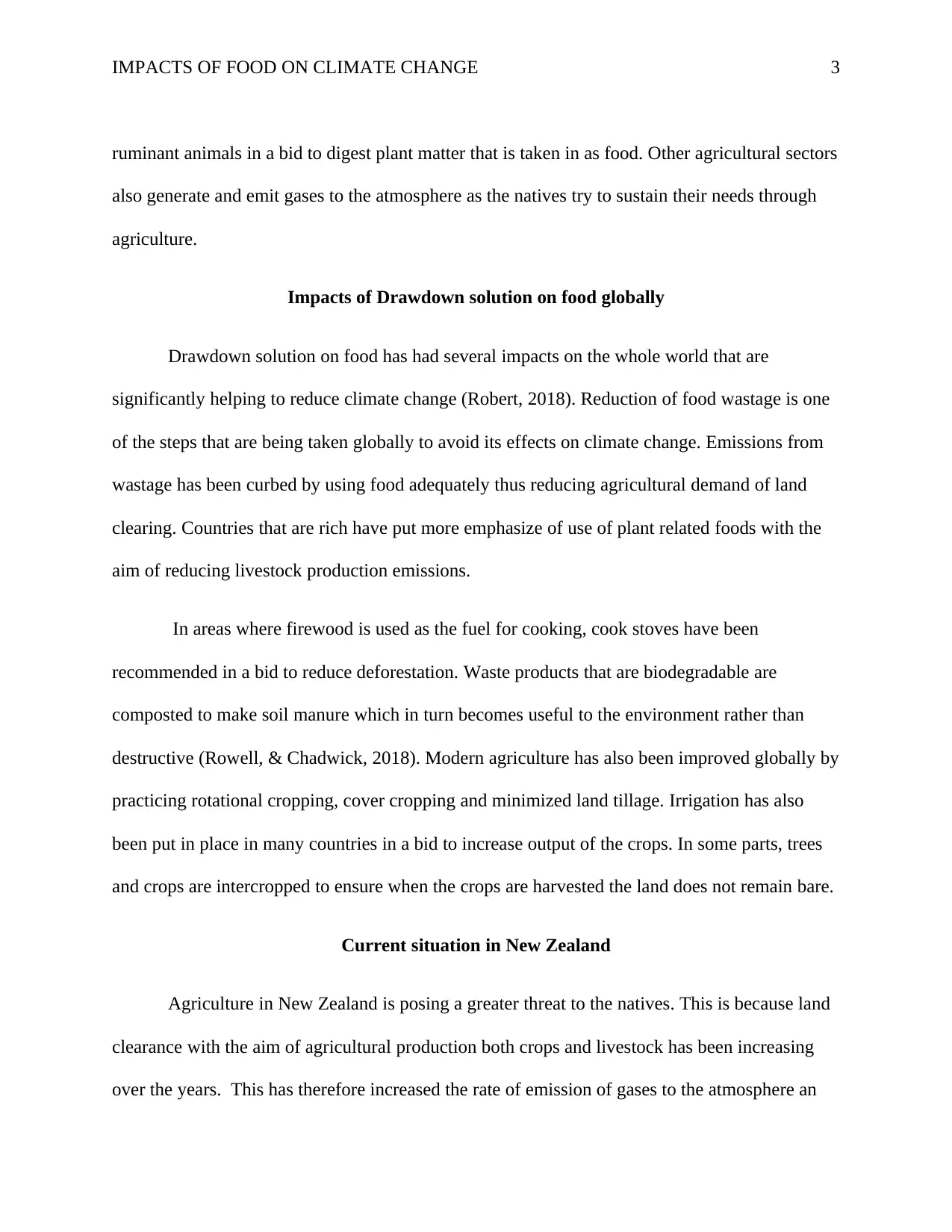
IMPACTS OF FOOD ON CLIMATE CHANGE 3
ruminant animals in a bid to digest plant matter that is taken in as food. Other agricultural sectors
also generate and emit gases to the atmosphere as the natives try to sustain their needs through
agriculture.
Impacts of Drawdown solution on food globally
Drawdown solution on food has had several impacts on the whole world that are
significantly helping to reduce climate change (Robert, 2018). Reduction of food wastage is one
of the steps that are being taken globally to avoid its effects on climate change. Emissions from
wastage has been curbed by using food adequately thus reducing agricultural demand of land
clearing. Countries that are rich have put more emphasize of use of plant related foods with the
aim of reducing livestock production emissions.
In areas where firewood is used as the fuel for cooking, cook stoves have been
recommended in a bid to reduce deforestation. Waste products that are biodegradable are
composted to make soil manure which in turn becomes useful to the environment rather than
destructive (Rowell, & Chadwick, 2018). Modern agriculture has also been improved globally by
practicing rotational cropping, cover cropping and minimized land tillage. Irrigation has also
been put in place in many countries in a bid to increase output of the crops. In some parts, trees
and crops are intercropped to ensure when the crops are harvested the land does not remain bare.
Current situation in New Zealand
Agriculture in New Zealand is posing a greater threat to the natives. This is because land
clearance with the aim of agricultural production both crops and livestock has been increasing
over the years. This has therefore increased the rate of emission of gases to the atmosphere an
ruminant animals in a bid to digest plant matter that is taken in as food. Other agricultural sectors
also generate and emit gases to the atmosphere as the natives try to sustain their needs through
agriculture.
Impacts of Drawdown solution on food globally
Drawdown solution on food has had several impacts on the whole world that are
significantly helping to reduce climate change (Robert, 2018). Reduction of food wastage is one
of the steps that are being taken globally to avoid its effects on climate change. Emissions from
wastage has been curbed by using food adequately thus reducing agricultural demand of land
clearing. Countries that are rich have put more emphasize of use of plant related foods with the
aim of reducing livestock production emissions.
In areas where firewood is used as the fuel for cooking, cook stoves have been
recommended in a bid to reduce deforestation. Waste products that are biodegradable are
composted to make soil manure which in turn becomes useful to the environment rather than
destructive (Rowell, & Chadwick, 2018). Modern agriculture has also been improved globally by
practicing rotational cropping, cover cropping and minimized land tillage. Irrigation has also
been put in place in many countries in a bid to increase output of the crops. In some parts, trees
and crops are intercropped to ensure when the crops are harvested the land does not remain bare.
Current situation in New Zealand
Agriculture in New Zealand is posing a greater threat to the natives. This is because land
clearance with the aim of agricultural production both crops and livestock has been increasing
over the years. This has therefore increased the rate of emission of gases to the atmosphere an
⊘ This is a preview!⊘
Do you want full access?
Subscribe today to unlock all pages.

Trusted by 1+ million students worldwide
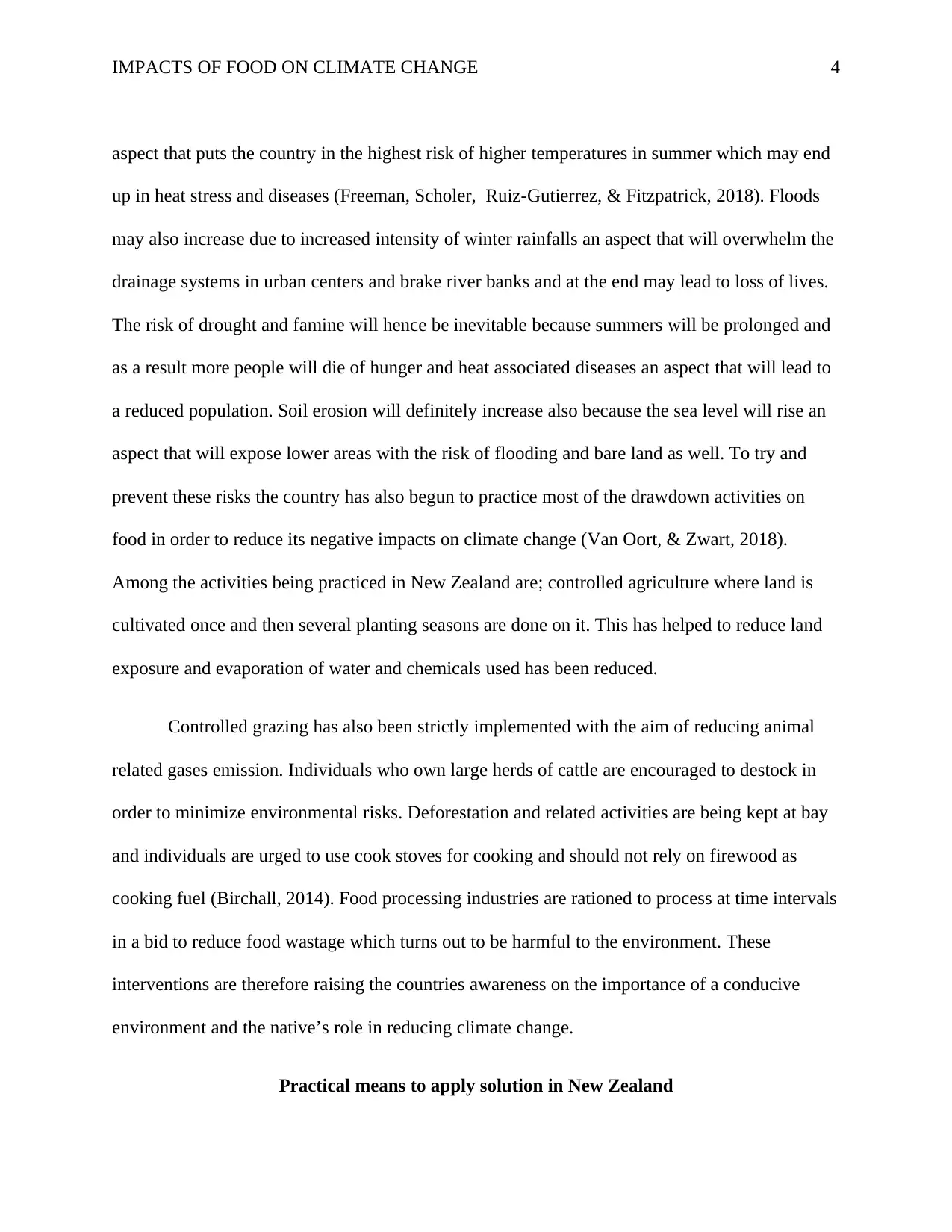
IMPACTS OF FOOD ON CLIMATE CHANGE 4
aspect that puts the country in the highest risk of higher temperatures in summer which may end
up in heat stress and diseases (Freeman, Scholer, Ruiz-Gutierrez, & Fitzpatrick, 2018). Floods
may also increase due to increased intensity of winter rainfalls an aspect that will overwhelm the
drainage systems in urban centers and brake river banks and at the end may lead to loss of lives.
The risk of drought and famine will hence be inevitable because summers will be prolonged and
as a result more people will die of hunger and heat associated diseases an aspect that will lead to
a reduced population. Soil erosion will definitely increase also because the sea level will rise an
aspect that will expose lower areas with the risk of flooding and bare land as well. To try and
prevent these risks the country has also begun to practice most of the drawdown activities on
food in order to reduce its negative impacts on climate change (Van Oort, & Zwart, 2018).
Among the activities being practiced in New Zealand are; controlled agriculture where land is
cultivated once and then several planting seasons are done on it. This has helped to reduce land
exposure and evaporation of water and chemicals used has been reduced.
Controlled grazing has also been strictly implemented with the aim of reducing animal
related gases emission. Individuals who own large herds of cattle are encouraged to destock in
order to minimize environmental risks. Deforestation and related activities are being kept at bay
and individuals are urged to use cook stoves for cooking and should not rely on firewood as
cooking fuel (Birchall, 2014). Food processing industries are rationed to process at time intervals
in a bid to reduce food wastage which turns out to be harmful to the environment. These
interventions are therefore raising the countries awareness on the importance of a conducive
environment and the native’s role in reducing climate change.
Practical means to apply solution in New Zealand
aspect that puts the country in the highest risk of higher temperatures in summer which may end
up in heat stress and diseases (Freeman, Scholer, Ruiz-Gutierrez, & Fitzpatrick, 2018). Floods
may also increase due to increased intensity of winter rainfalls an aspect that will overwhelm the
drainage systems in urban centers and brake river banks and at the end may lead to loss of lives.
The risk of drought and famine will hence be inevitable because summers will be prolonged and
as a result more people will die of hunger and heat associated diseases an aspect that will lead to
a reduced population. Soil erosion will definitely increase also because the sea level will rise an
aspect that will expose lower areas with the risk of flooding and bare land as well. To try and
prevent these risks the country has also begun to practice most of the drawdown activities on
food in order to reduce its negative impacts on climate change (Van Oort, & Zwart, 2018).
Among the activities being practiced in New Zealand are; controlled agriculture where land is
cultivated once and then several planting seasons are done on it. This has helped to reduce land
exposure and evaporation of water and chemicals used has been reduced.
Controlled grazing has also been strictly implemented with the aim of reducing animal
related gases emission. Individuals who own large herds of cattle are encouraged to destock in
order to minimize environmental risks. Deforestation and related activities are being kept at bay
and individuals are urged to use cook stoves for cooking and should not rely on firewood as
cooking fuel (Birchall, 2014). Food processing industries are rationed to process at time intervals
in a bid to reduce food wastage which turns out to be harmful to the environment. These
interventions are therefore raising the countries awareness on the importance of a conducive
environment and the native’s role in reducing climate change.
Practical means to apply solution in New Zealand
Paraphrase This Document
Need a fresh take? Get an instant paraphrase of this document with our AI Paraphraser
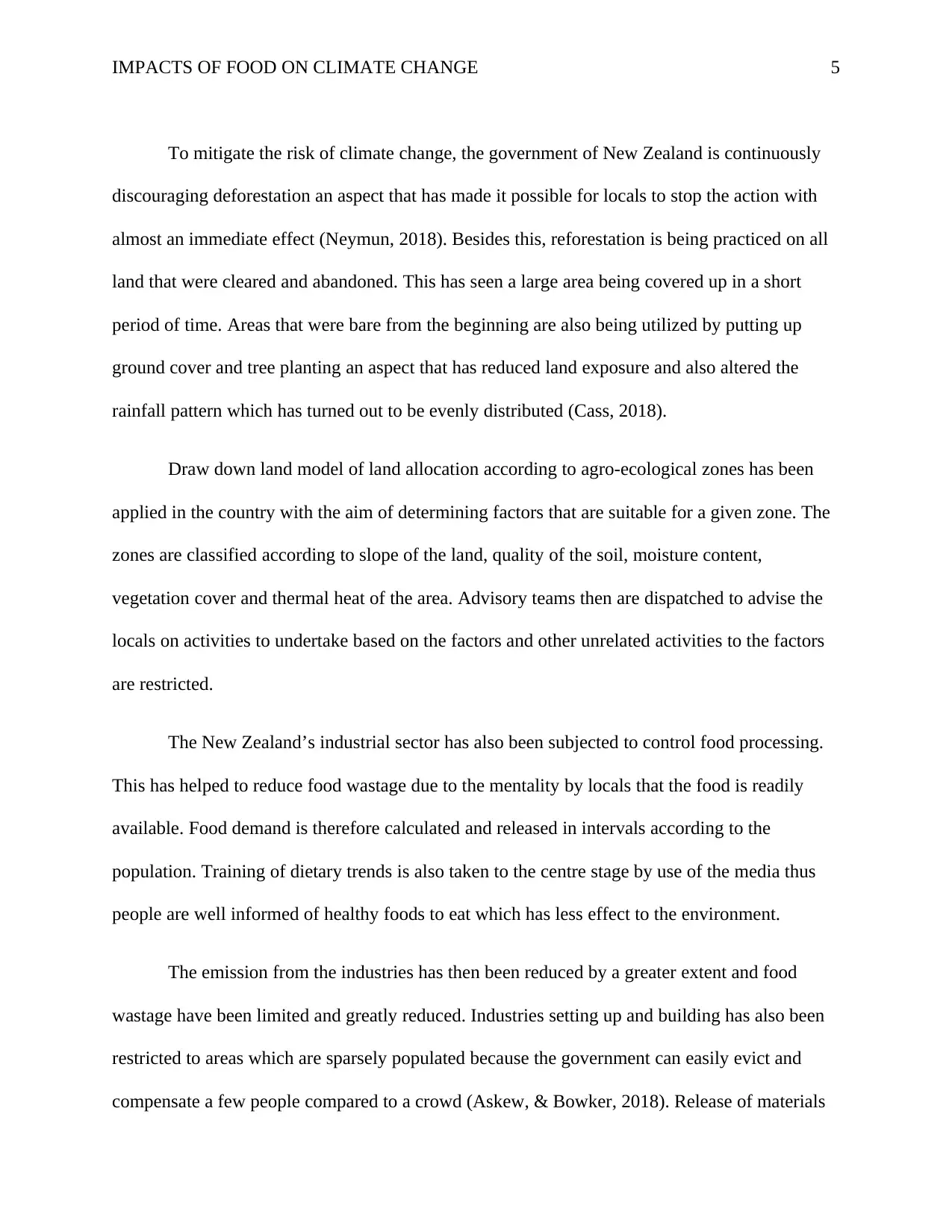
IMPACTS OF FOOD ON CLIMATE CHANGE 5
To mitigate the risk of climate change, the government of New Zealand is continuously
discouraging deforestation an aspect that has made it possible for locals to stop the action with
almost an immediate effect (Neymun, 2018). Besides this, reforestation is being practiced on all
land that were cleared and abandoned. This has seen a large area being covered up in a short
period of time. Areas that were bare from the beginning are also being utilized by putting up
ground cover and tree planting an aspect that has reduced land exposure and also altered the
rainfall pattern which has turned out to be evenly distributed (Cass, 2018).
Draw down land model of land allocation according to agro-ecological zones has been
applied in the country with the aim of determining factors that are suitable for a given zone. The
zones are classified according to slope of the land, quality of the soil, moisture content,
vegetation cover and thermal heat of the area. Advisory teams then are dispatched to advise the
locals on activities to undertake based on the factors and other unrelated activities to the factors
are restricted.
The New Zealand’s industrial sector has also been subjected to control food processing.
This has helped to reduce food wastage due to the mentality by locals that the food is readily
available. Food demand is therefore calculated and released in intervals according to the
population. Training of dietary trends is also taken to the centre stage by use of the media thus
people are well informed of healthy foods to eat which has less effect to the environment.
The emission from the industries has then been reduced by a greater extent and food
wastage have been limited and greatly reduced. Industries setting up and building has also been
restricted to areas which are sparsely populated because the government can easily evict and
compensate a few people compared to a crowd (Askew, & Bowker, 2018). Release of materials
To mitigate the risk of climate change, the government of New Zealand is continuously
discouraging deforestation an aspect that has made it possible for locals to stop the action with
almost an immediate effect (Neymun, 2018). Besides this, reforestation is being practiced on all
land that were cleared and abandoned. This has seen a large area being covered up in a short
period of time. Areas that were bare from the beginning are also being utilized by putting up
ground cover and tree planting an aspect that has reduced land exposure and also altered the
rainfall pattern which has turned out to be evenly distributed (Cass, 2018).
Draw down land model of land allocation according to agro-ecological zones has been
applied in the country with the aim of determining factors that are suitable for a given zone. The
zones are classified according to slope of the land, quality of the soil, moisture content,
vegetation cover and thermal heat of the area. Advisory teams then are dispatched to advise the
locals on activities to undertake based on the factors and other unrelated activities to the factors
are restricted.
The New Zealand’s industrial sector has also been subjected to control food processing.
This has helped to reduce food wastage due to the mentality by locals that the food is readily
available. Food demand is therefore calculated and released in intervals according to the
population. Training of dietary trends is also taken to the centre stage by use of the media thus
people are well informed of healthy foods to eat which has less effect to the environment.
The emission from the industries has then been reduced by a greater extent and food
wastage have been limited and greatly reduced. Industries setting up and building has also been
restricted to areas which are sparsely populated because the government can easily evict and
compensate a few people compared to a crowd (Askew, & Bowker, 2018). Release of materials
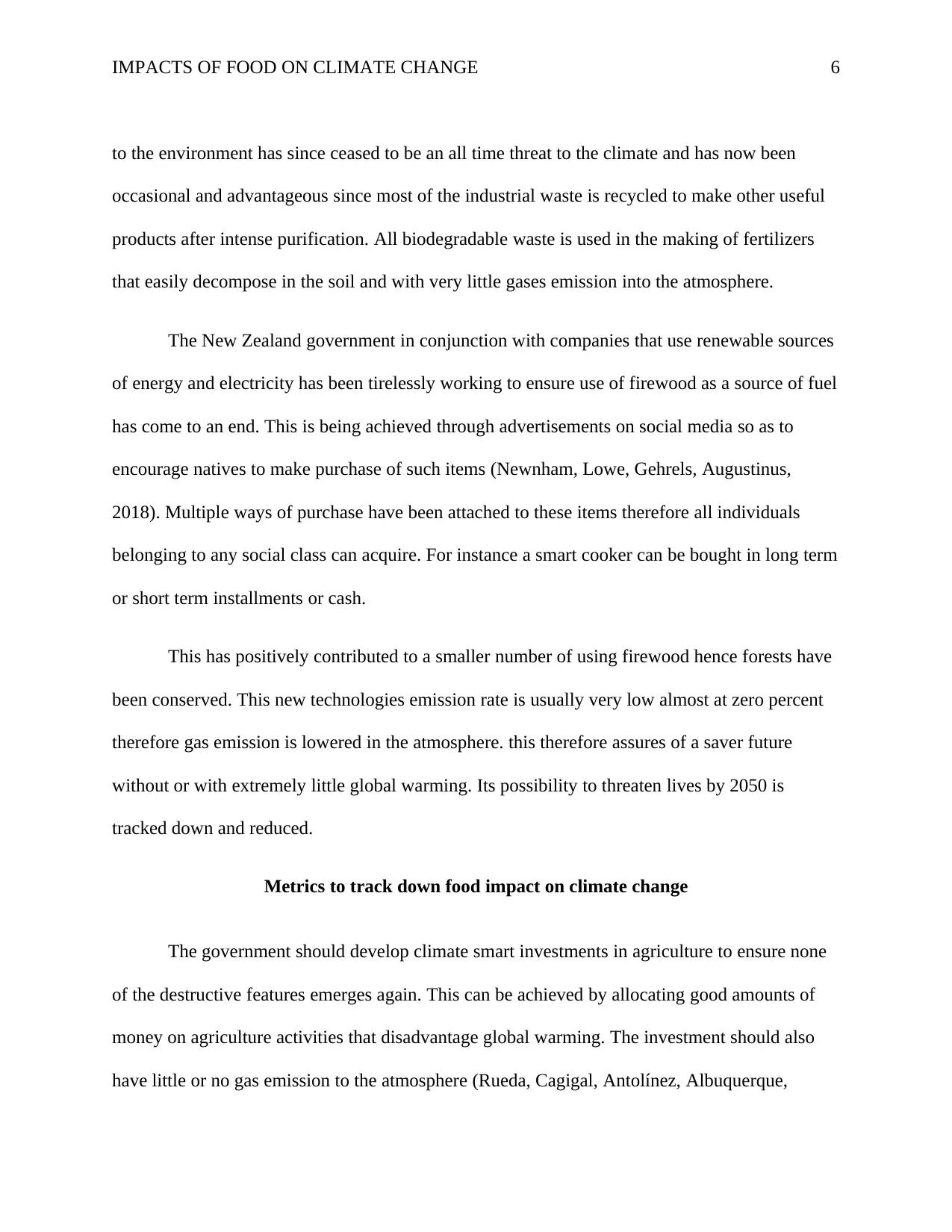
IMPACTS OF FOOD ON CLIMATE CHANGE 6
to the environment has since ceased to be an all time threat to the climate and has now been
occasional and advantageous since most of the industrial waste is recycled to make other useful
products after intense purification. All biodegradable waste is used in the making of fertilizers
that easily decompose in the soil and with very little gases emission into the atmosphere.
The New Zealand government in conjunction with companies that use renewable sources
of energy and electricity has been tirelessly working to ensure use of firewood as a source of fuel
has come to an end. This is being achieved through advertisements on social media so as to
encourage natives to make purchase of such items (Newnham, Lowe, Gehrels, Augustinus,
2018). Multiple ways of purchase have been attached to these items therefore all individuals
belonging to any social class can acquire. For instance a smart cooker can be bought in long term
or short term installments or cash.
This has positively contributed to a smaller number of using firewood hence forests have
been conserved. This new technologies emission rate is usually very low almost at zero percent
therefore gas emission is lowered in the atmosphere. this therefore assures of a saver future
without or with extremely little global warming. Its possibility to threaten lives by 2050 is
tracked down and reduced.
Metrics to track down food impact on climate change
The government should develop climate smart investments in agriculture to ensure none
of the destructive features emerges again. This can be achieved by allocating good amounts of
money on agriculture activities that disadvantage global warming. The investment should also
have little or no gas emission to the atmosphere (Rueda, Cagigal, Antolínez, Albuquerque,
to the environment has since ceased to be an all time threat to the climate and has now been
occasional and advantageous since most of the industrial waste is recycled to make other useful
products after intense purification. All biodegradable waste is used in the making of fertilizers
that easily decompose in the soil and with very little gases emission into the atmosphere.
The New Zealand government in conjunction with companies that use renewable sources
of energy and electricity has been tirelessly working to ensure use of firewood as a source of fuel
has come to an end. This is being achieved through advertisements on social media so as to
encourage natives to make purchase of such items (Newnham, Lowe, Gehrels, Augustinus,
2018). Multiple ways of purchase have been attached to these items therefore all individuals
belonging to any social class can acquire. For instance a smart cooker can be bought in long term
or short term installments or cash.
This has positively contributed to a smaller number of using firewood hence forests have
been conserved. This new technologies emission rate is usually very low almost at zero percent
therefore gas emission is lowered in the atmosphere. this therefore assures of a saver future
without or with extremely little global warming. Its possibility to threaten lives by 2050 is
tracked down and reduced.
Metrics to track down food impact on climate change
The government should develop climate smart investments in agriculture to ensure none
of the destructive features emerges again. This can be achieved by allocating good amounts of
money on agriculture activities that disadvantage global warming. The investment should also
have little or no gas emission to the atmosphere (Rueda, Cagigal, Antolínez, Albuquerque,
⊘ This is a preview!⊘
Do you want full access?
Subscribe today to unlock all pages.

Trusted by 1+ million students worldwide
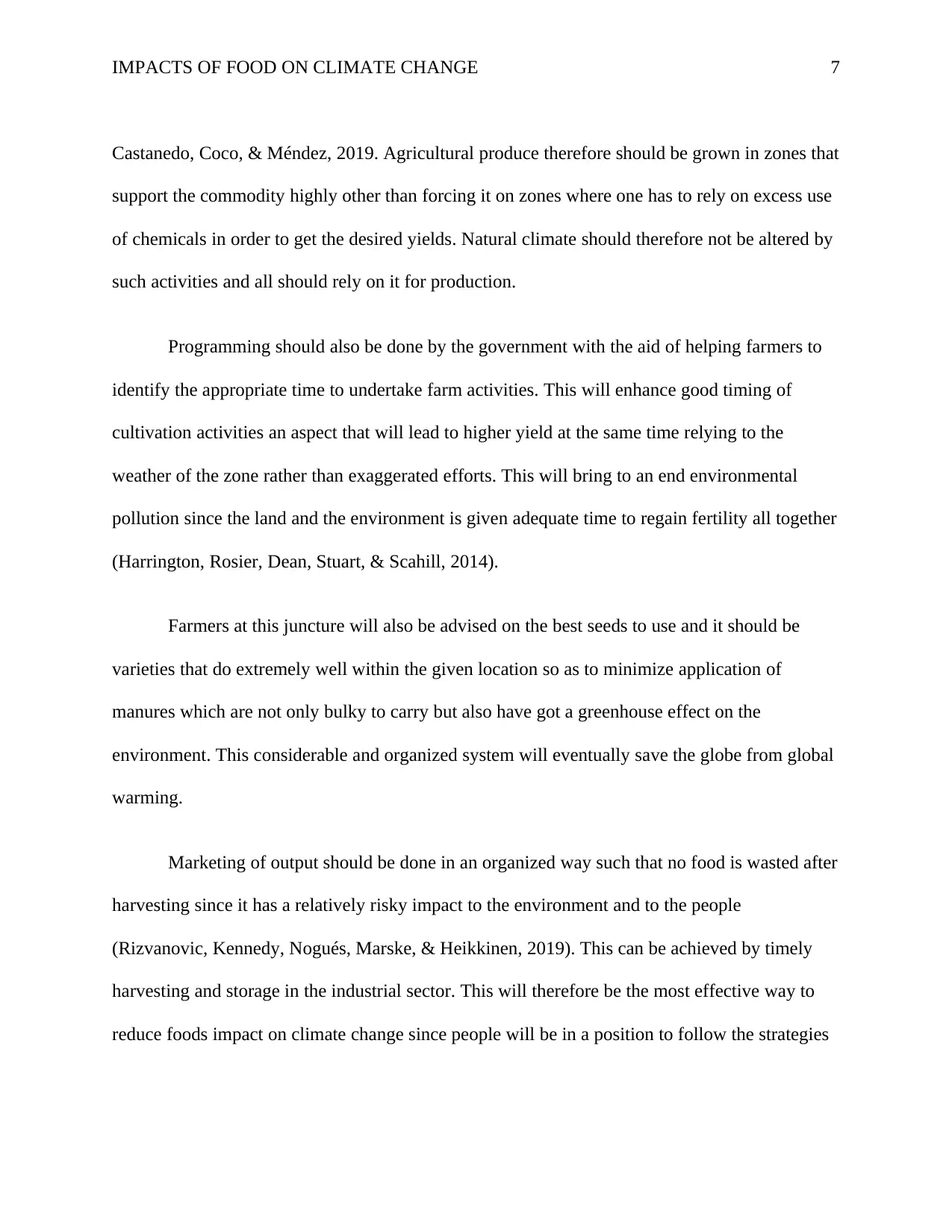
IMPACTS OF FOOD ON CLIMATE CHANGE 7
Castanedo, Coco, & Méndez, 2019. Agricultural produce therefore should be grown in zones that
support the commodity highly other than forcing it on zones where one has to rely on excess use
of chemicals in order to get the desired yields. Natural climate should therefore not be altered by
such activities and all should rely on it for production.
Programming should also be done by the government with the aid of helping farmers to
identify the appropriate time to undertake farm activities. This will enhance good timing of
cultivation activities an aspect that will lead to higher yield at the same time relying to the
weather of the zone rather than exaggerated efforts. This will bring to an end environmental
pollution since the land and the environment is given adequate time to regain fertility all together
(Harrington, Rosier, Dean, Stuart, & Scahill, 2014).
Farmers at this juncture will also be advised on the best seeds to use and it should be
varieties that do extremely well within the given location so as to minimize application of
manures which are not only bulky to carry but also have got a greenhouse effect on the
environment. This considerable and organized system will eventually save the globe from global
warming.
Marketing of output should be done in an organized way such that no food is wasted after
harvesting since it has a relatively risky impact to the environment and to the people
(Rizvanovic, Kennedy, Nogués, Marske, & Heikkinen, 2019). This can be achieved by timely
harvesting and storage in the industrial sector. This will therefore be the most effective way to
reduce foods impact on climate change since people will be in a position to follow the strategies
Castanedo, Coco, & Méndez, 2019. Agricultural produce therefore should be grown in zones that
support the commodity highly other than forcing it on zones where one has to rely on excess use
of chemicals in order to get the desired yields. Natural climate should therefore not be altered by
such activities and all should rely on it for production.
Programming should also be done by the government with the aid of helping farmers to
identify the appropriate time to undertake farm activities. This will enhance good timing of
cultivation activities an aspect that will lead to higher yield at the same time relying to the
weather of the zone rather than exaggerated efforts. This will bring to an end environmental
pollution since the land and the environment is given adequate time to regain fertility all together
(Harrington, Rosier, Dean, Stuart, & Scahill, 2014).
Farmers at this juncture will also be advised on the best seeds to use and it should be
varieties that do extremely well within the given location so as to minimize application of
manures which are not only bulky to carry but also have got a greenhouse effect on the
environment. This considerable and organized system will eventually save the globe from global
warming.
Marketing of output should be done in an organized way such that no food is wasted after
harvesting since it has a relatively risky impact to the environment and to the people
(Rizvanovic, Kennedy, Nogués, Marske, & Heikkinen, 2019). This can be achieved by timely
harvesting and storage in the industrial sector. This will therefore be the most effective way to
reduce foods impact on climate change since people will be in a position to follow the strategies
Paraphrase This Document
Need a fresh take? Get an instant paraphrase of this document with our AI Paraphraser
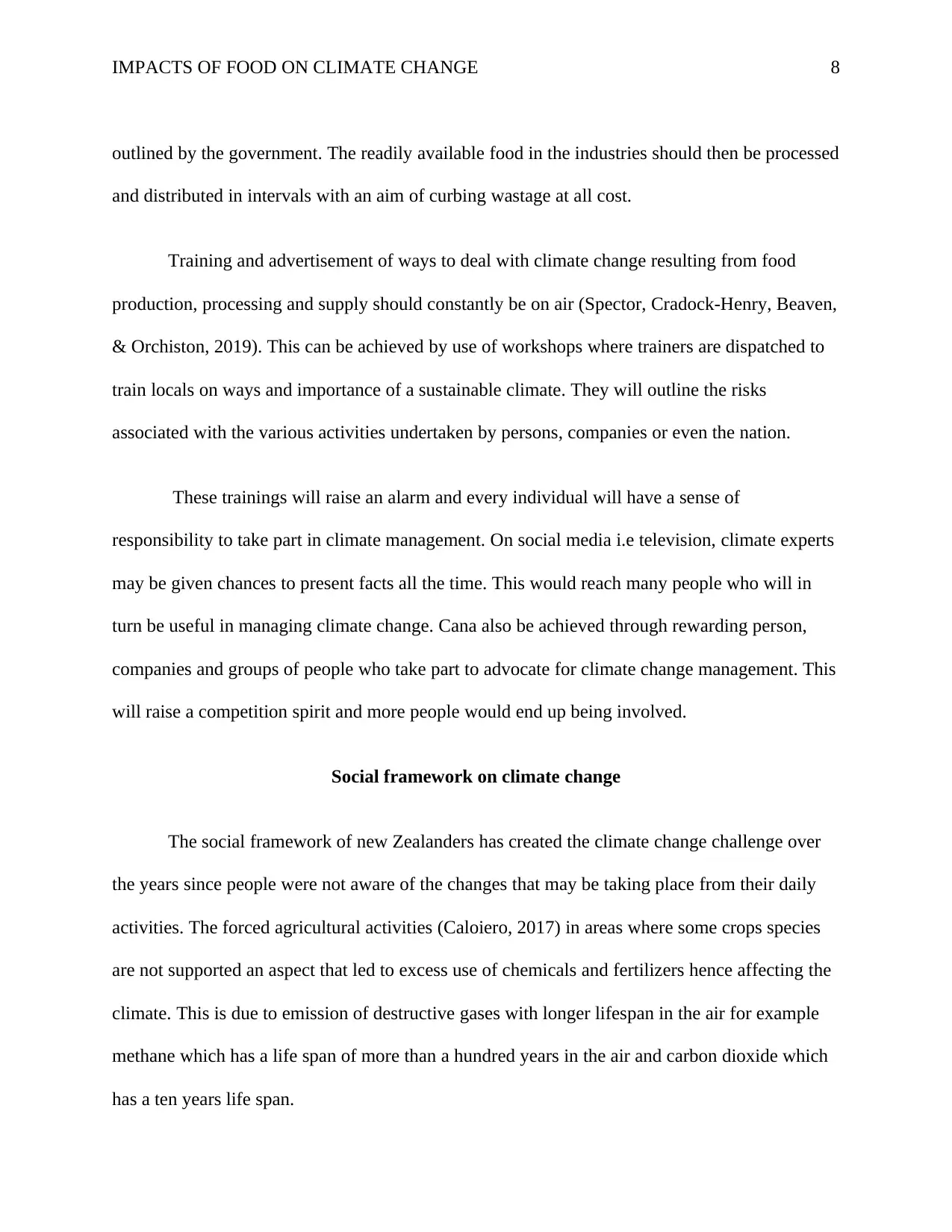
IMPACTS OF FOOD ON CLIMATE CHANGE 8
outlined by the government. The readily available food in the industries should then be processed
and distributed in intervals with an aim of curbing wastage at all cost.
Training and advertisement of ways to deal with climate change resulting from food
production, processing and supply should constantly be on air (Spector, Cradock-Henry, Beaven,
& Orchiston, 2019). This can be achieved by use of workshops where trainers are dispatched to
train locals on ways and importance of a sustainable climate. They will outline the risks
associated with the various activities undertaken by persons, companies or even the nation.
These trainings will raise an alarm and every individual will have a sense of
responsibility to take part in climate management. On social media i.e television, climate experts
may be given chances to present facts all the time. This would reach many people who will in
turn be useful in managing climate change. Cana also be achieved through rewarding person,
companies and groups of people who take part to advocate for climate change management. This
will raise a competition spirit and more people would end up being involved.
Social framework on climate change
The social framework of new Zealanders has created the climate change challenge over
the years since people were not aware of the changes that may be taking place from their daily
activities. The forced agricultural activities (Caloiero, 2017) in areas where some crops species
are not supported an aspect that led to excess use of chemicals and fertilizers hence affecting the
climate. This is due to emission of destructive gases with longer lifespan in the air for example
methane which has a life span of more than a hundred years in the air and carbon dioxide which
has a ten years life span.
outlined by the government. The readily available food in the industries should then be processed
and distributed in intervals with an aim of curbing wastage at all cost.
Training and advertisement of ways to deal with climate change resulting from food
production, processing and supply should constantly be on air (Spector, Cradock-Henry, Beaven,
& Orchiston, 2019). This can be achieved by use of workshops where trainers are dispatched to
train locals on ways and importance of a sustainable climate. They will outline the risks
associated with the various activities undertaken by persons, companies or even the nation.
These trainings will raise an alarm and every individual will have a sense of
responsibility to take part in climate management. On social media i.e television, climate experts
may be given chances to present facts all the time. This would reach many people who will in
turn be useful in managing climate change. Cana also be achieved through rewarding person,
companies and groups of people who take part to advocate for climate change management. This
will raise a competition spirit and more people would end up being involved.
Social framework on climate change
The social framework of new Zealanders has created the climate change challenge over
the years since people were not aware of the changes that may be taking place from their daily
activities. The forced agricultural activities (Caloiero, 2017) in areas where some crops species
are not supported an aspect that led to excess use of chemicals and fertilizers hence affecting the
climate. This is due to emission of destructive gases with longer lifespan in the air for example
methane which has a life span of more than a hundred years in the air and carbon dioxide which
has a ten years life span.
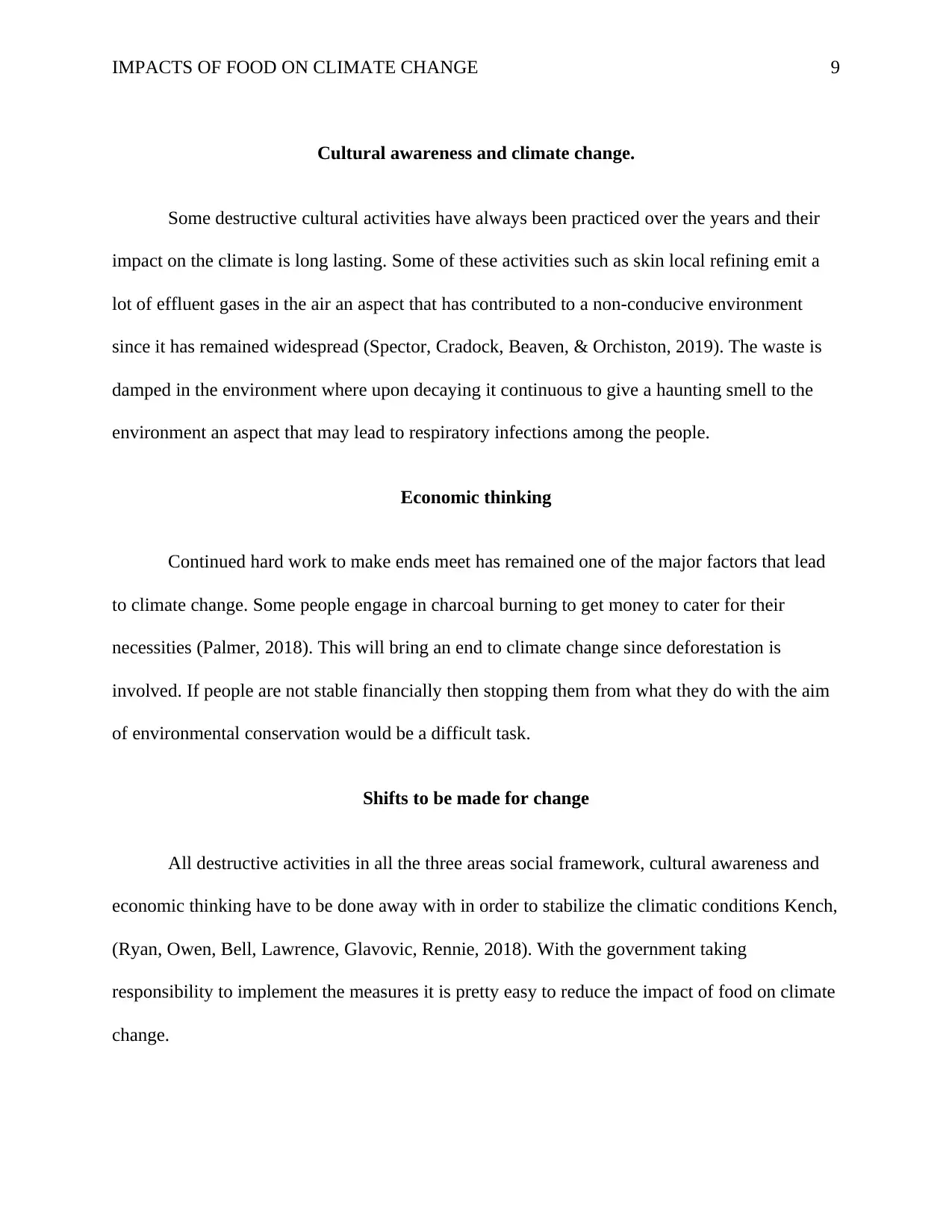
IMPACTS OF FOOD ON CLIMATE CHANGE 9
Cultural awareness and climate change.
Some destructive cultural activities have always been practiced over the years and their
impact on the climate is long lasting. Some of these activities such as skin local refining emit a
lot of effluent gases in the air an aspect that has contributed to a non-conducive environment
since it has remained widespread (Spector, Cradock, Beaven, & Orchiston, 2019). The waste is
damped in the environment where upon decaying it continuous to give a haunting smell to the
environment an aspect that may lead to respiratory infections among the people.
Economic thinking
Continued hard work to make ends meet has remained one of the major factors that lead
to climate change. Some people engage in charcoal burning to get money to cater for their
necessities (Palmer, 2018). This will bring an end to climate change since deforestation is
involved. If people are not stable financially then stopping them from what they do with the aim
of environmental conservation would be a difficult task.
Shifts to be made for change
All destructive activities in all the three areas social framework, cultural awareness and
economic thinking have to be done away with in order to stabilize the climatic conditions Kench,
(Ryan, Owen, Bell, Lawrence, Glavovic, Rennie, 2018). With the government taking
responsibility to implement the measures it is pretty easy to reduce the impact of food on climate
change.
Cultural awareness and climate change.
Some destructive cultural activities have always been practiced over the years and their
impact on the climate is long lasting. Some of these activities such as skin local refining emit a
lot of effluent gases in the air an aspect that has contributed to a non-conducive environment
since it has remained widespread (Spector, Cradock, Beaven, & Orchiston, 2019). The waste is
damped in the environment where upon decaying it continuous to give a haunting smell to the
environment an aspect that may lead to respiratory infections among the people.
Economic thinking
Continued hard work to make ends meet has remained one of the major factors that lead
to climate change. Some people engage in charcoal burning to get money to cater for their
necessities (Palmer, 2018). This will bring an end to climate change since deforestation is
involved. If people are not stable financially then stopping them from what they do with the aim
of environmental conservation would be a difficult task.
Shifts to be made for change
All destructive activities in all the three areas social framework, cultural awareness and
economic thinking have to be done away with in order to stabilize the climatic conditions Kench,
(Ryan, Owen, Bell, Lawrence, Glavovic, Rennie, 2018). With the government taking
responsibility to implement the measures it is pretty easy to reduce the impact of food on climate
change.
⊘ This is a preview!⊘
Do you want full access?
Subscribe today to unlock all pages.

Trusted by 1+ million students worldwide
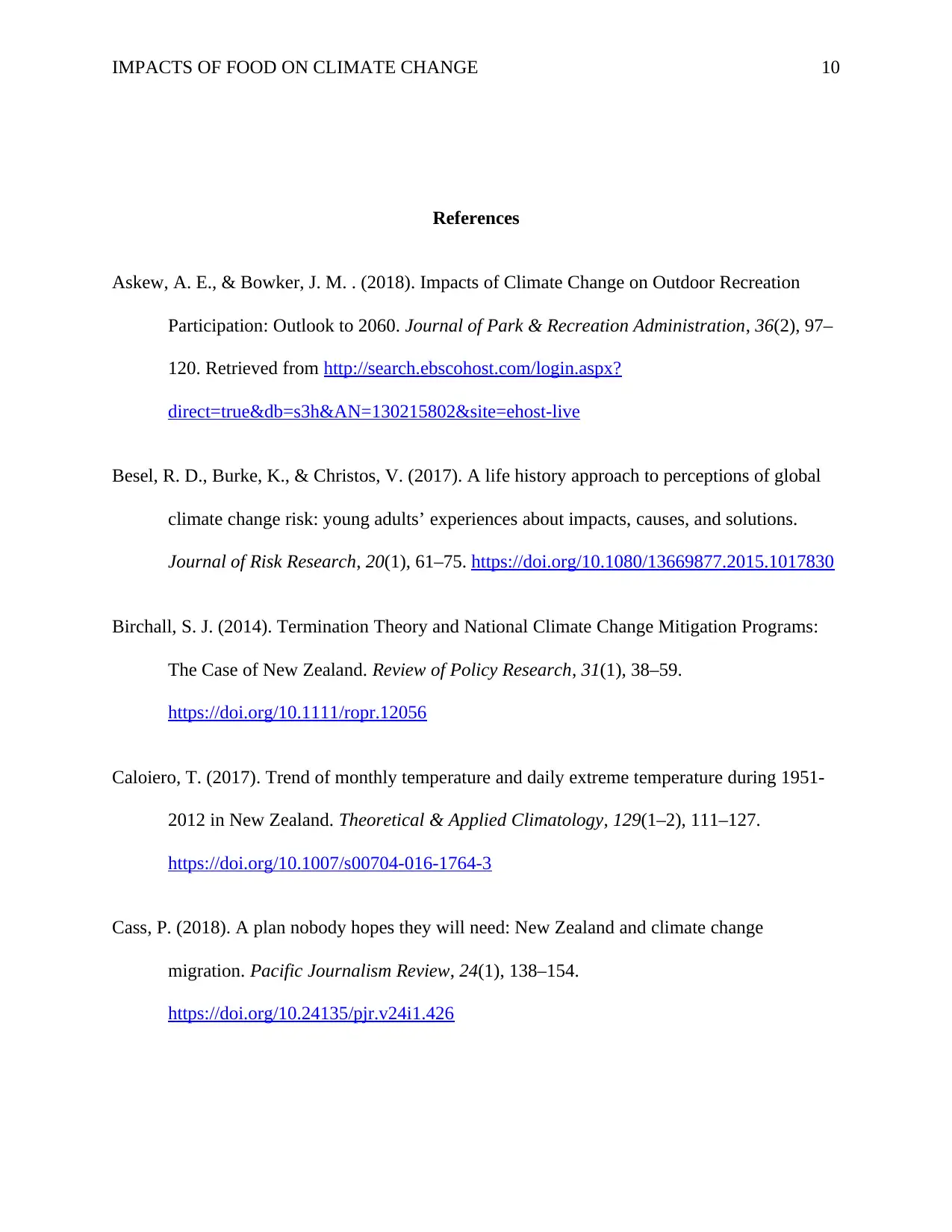
IMPACTS OF FOOD ON CLIMATE CHANGE 10
References
Askew, A. E., & Bowker, J. M. . (2018). Impacts of Climate Change on Outdoor Recreation
Participation: Outlook to 2060. Journal of Park & Recreation Administration, 36(2), 97–
120. Retrieved from http://search.ebscohost.com/login.aspx?
direct=true&db=s3h&AN=130215802&site=ehost-live
Besel, R. D., Burke, K., & Christos, V. (2017). A life history approach to perceptions of global
climate change risk: young adults’ experiences about impacts, causes, and solutions.
Journal of Risk Research, 20(1), 61–75. https://doi.org/10.1080/13669877.2015.1017830
Birchall, S. J. (2014). Termination Theory and National Climate Change Mitigation Programs:
The Case of New Zealand. Review of Policy Research, 31(1), 38–59.
https://doi.org/10.1111/ropr.12056
Caloiero, T. (2017). Trend of monthly temperature and daily extreme temperature during 1951-
2012 in New Zealand. Theoretical & Applied Climatology, 129(1–2), 111–127.
https://doi.org/10.1007/s00704-016-1764-3
Cass, P. (2018). A plan nobody hopes they will need: New Zealand and climate change
migration. Pacific Journalism Review, 24(1), 138–154.
https://doi.org/10.24135/pjr.v24i1.426
References
Askew, A. E., & Bowker, J. M. . (2018). Impacts of Climate Change on Outdoor Recreation
Participation: Outlook to 2060. Journal of Park & Recreation Administration, 36(2), 97–
120. Retrieved from http://search.ebscohost.com/login.aspx?
direct=true&db=s3h&AN=130215802&site=ehost-live
Besel, R. D., Burke, K., & Christos, V. (2017). A life history approach to perceptions of global
climate change risk: young adults’ experiences about impacts, causes, and solutions.
Journal of Risk Research, 20(1), 61–75. https://doi.org/10.1080/13669877.2015.1017830
Birchall, S. J. (2014). Termination Theory and National Climate Change Mitigation Programs:
The Case of New Zealand. Review of Policy Research, 31(1), 38–59.
https://doi.org/10.1111/ropr.12056
Caloiero, T. (2017). Trend of monthly temperature and daily extreme temperature during 1951-
2012 in New Zealand. Theoretical & Applied Climatology, 129(1–2), 111–127.
https://doi.org/10.1007/s00704-016-1764-3
Cass, P. (2018). A plan nobody hopes they will need: New Zealand and climate change
migration. Pacific Journalism Review, 24(1), 138–154.
https://doi.org/10.24135/pjr.v24i1.426
Paraphrase This Document
Need a fresh take? Get an instant paraphrase of this document with our AI Paraphraser
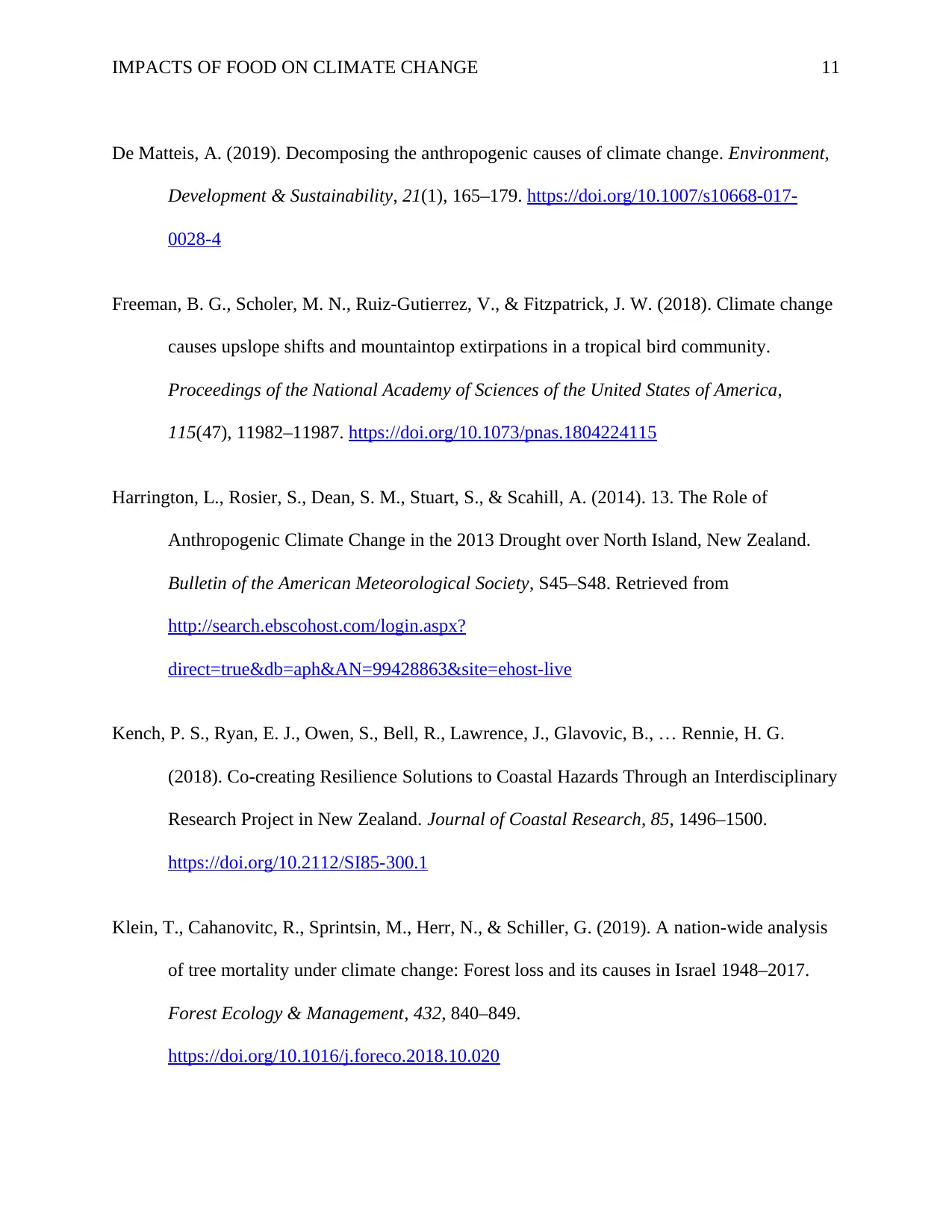
IMPACTS OF FOOD ON CLIMATE CHANGE 11
De Matteis, A. (2019). Decomposing the anthropogenic causes of climate change. Environment,
Development & Sustainability, 21(1), 165–179. https://doi.org/10.1007/s10668-017-
0028-4
Freeman, B. G., Scholer, M. N., Ruiz-Gutierrez, V., & Fitzpatrick, J. W. (2018). Climate change
causes upslope shifts and mountaintop extirpations in a tropical bird community.
Proceedings of the National Academy of Sciences of the United States of America,
115(47), 11982–11987. https://doi.org/10.1073/pnas.1804224115
Harrington, L., Rosier, S., Dean, S. M., Stuart, S., & Scahill, A. (2014). 13. The Role of
Anthropogenic Climate Change in the 2013 Drought over North Island, New Zealand.
Bulletin of the American Meteorological Society, S45–S48. Retrieved from
http://search.ebscohost.com/login.aspx?
direct=true&db=aph&AN=99428863&site=ehost-live
Kench, P. S., Ryan, E. J., Owen, S., Bell, R., Lawrence, J., Glavovic, B., … Rennie, H. G.
(2018). Co-creating Resilience Solutions to Coastal Hazards Through an Interdisciplinary
Research Project in New Zealand. Journal of Coastal Research, 85, 1496–1500.
https://doi.org/10.2112/SI85-300.1
Klein, T., Cahanovitc, R., Sprintsin, M., Herr, N., & Schiller, G. (2019). A nation-wide analysis
of tree mortality under climate change: Forest loss and its causes in Israel 1948–2017.
Forest Ecology & Management, 432, 840–849.
https://doi.org/10.1016/j.foreco.2018.10.020
De Matteis, A. (2019). Decomposing the anthropogenic causes of climate change. Environment,
Development & Sustainability, 21(1), 165–179. https://doi.org/10.1007/s10668-017-
0028-4
Freeman, B. G., Scholer, M. N., Ruiz-Gutierrez, V., & Fitzpatrick, J. W. (2018). Climate change
causes upslope shifts and mountaintop extirpations in a tropical bird community.
Proceedings of the National Academy of Sciences of the United States of America,
115(47), 11982–11987. https://doi.org/10.1073/pnas.1804224115
Harrington, L., Rosier, S., Dean, S. M., Stuart, S., & Scahill, A. (2014). 13. The Role of
Anthropogenic Climate Change in the 2013 Drought over North Island, New Zealand.
Bulletin of the American Meteorological Society, S45–S48. Retrieved from
http://search.ebscohost.com/login.aspx?
direct=true&db=aph&AN=99428863&site=ehost-live
Kench, P. S., Ryan, E. J., Owen, S., Bell, R., Lawrence, J., Glavovic, B., … Rennie, H. G.
(2018). Co-creating Resilience Solutions to Coastal Hazards Through an Interdisciplinary
Research Project in New Zealand. Journal of Coastal Research, 85, 1496–1500.
https://doi.org/10.2112/SI85-300.1
Klein, T., Cahanovitc, R., Sprintsin, M., Herr, N., & Schiller, G. (2019). A nation-wide analysis
of tree mortality under climate change: Forest loss and its causes in Israel 1948–2017.
Forest Ecology & Management, 432, 840–849.
https://doi.org/10.1016/j.foreco.2018.10.020
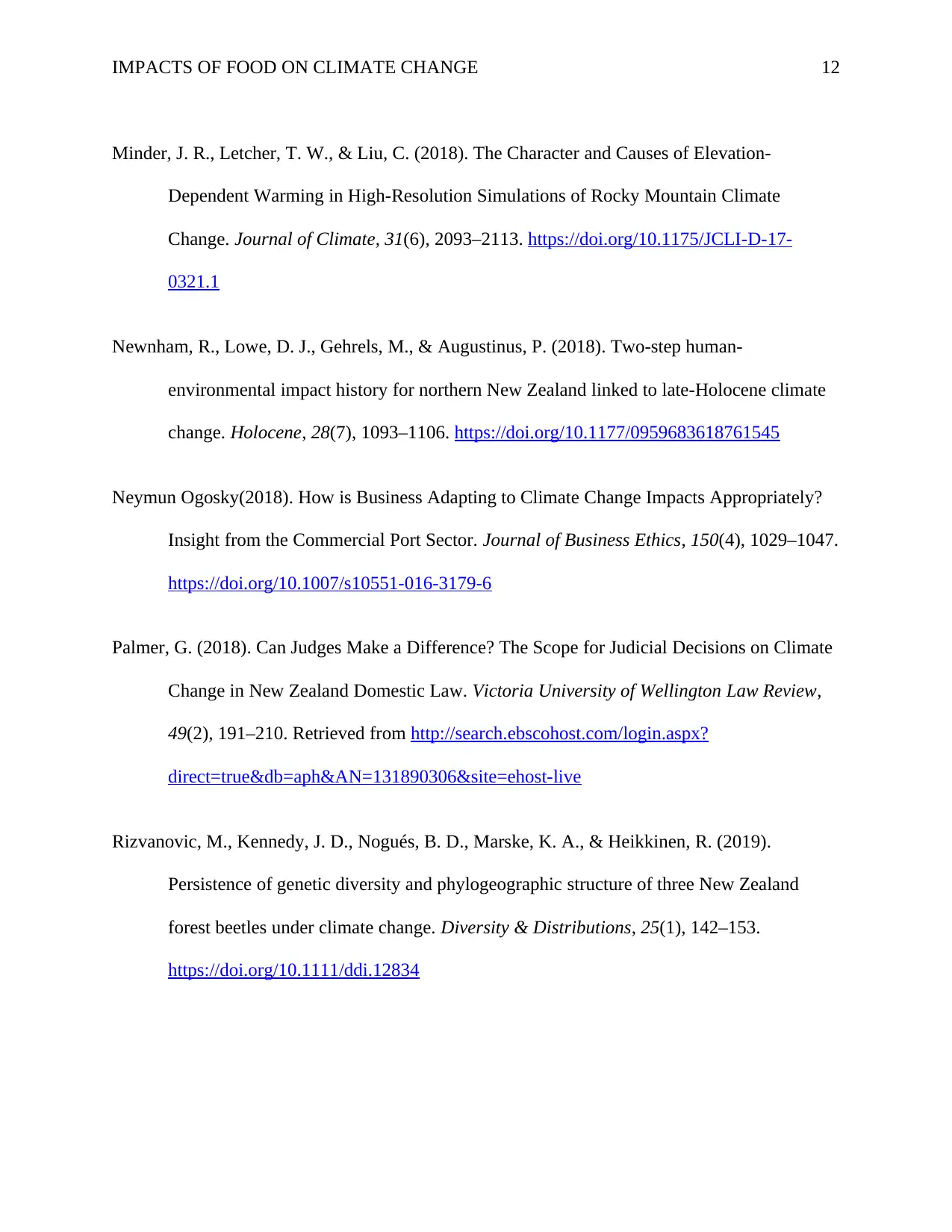
IMPACTS OF FOOD ON CLIMATE CHANGE 12
Minder, J. R., Letcher, T. W., & Liu, C. (2018). The Character and Causes of Elevation-
Dependent Warming in High-Resolution Simulations of Rocky Mountain Climate
Change. Journal of Climate, 31(6), 2093–2113. https://doi.org/10.1175/JCLI-D-17-
0321.1
Newnham, R., Lowe, D. J., Gehrels, M., & Augustinus, P. (2018). Two-step human-
environmental impact history for northern New Zealand linked to late-Holocene climate
change. Holocene, 28(7), 1093–1106. https://doi.org/10.1177/0959683618761545
Neymun Ogosky(2018). How is Business Adapting to Climate Change Impacts Appropriately?
Insight from the Commercial Port Sector. Journal of Business Ethics, 150(4), 1029–1047.
https://doi.org/10.1007/s10551-016-3179-6
Palmer, G. (2018). Can Judges Make a Difference? The Scope for Judicial Decisions on Climate
Change in New Zealand Domestic Law. Victoria University of Wellington Law Review,
49(2), 191–210. Retrieved from http://search.ebscohost.com/login.aspx?
direct=true&db=aph&AN=131890306&site=ehost-live
Rizvanovic, M., Kennedy, J. D., Nogués, B. D., Marske, K. A., & Heikkinen, R. (2019).
Persistence of genetic diversity and phylogeographic structure of three New Zealand
forest beetles under climate change. Diversity & Distributions, 25(1), 142–153.
https://doi.org/10.1111/ddi.12834
Minder, J. R., Letcher, T. W., & Liu, C. (2018). The Character and Causes of Elevation-
Dependent Warming in High-Resolution Simulations of Rocky Mountain Climate
Change. Journal of Climate, 31(6), 2093–2113. https://doi.org/10.1175/JCLI-D-17-
0321.1
Newnham, R., Lowe, D. J., Gehrels, M., & Augustinus, P. (2018). Two-step human-
environmental impact history for northern New Zealand linked to late-Holocene climate
change. Holocene, 28(7), 1093–1106. https://doi.org/10.1177/0959683618761545
Neymun Ogosky(2018). How is Business Adapting to Climate Change Impacts Appropriately?
Insight from the Commercial Port Sector. Journal of Business Ethics, 150(4), 1029–1047.
https://doi.org/10.1007/s10551-016-3179-6
Palmer, G. (2018). Can Judges Make a Difference? The Scope for Judicial Decisions on Climate
Change in New Zealand Domestic Law. Victoria University of Wellington Law Review,
49(2), 191–210. Retrieved from http://search.ebscohost.com/login.aspx?
direct=true&db=aph&AN=131890306&site=ehost-live
Rizvanovic, M., Kennedy, J. D., Nogués, B. D., Marske, K. A., & Heikkinen, R. (2019).
Persistence of genetic diversity and phylogeographic structure of three New Zealand
forest beetles under climate change. Diversity & Distributions, 25(1), 142–153.
https://doi.org/10.1111/ddi.12834
⊘ This is a preview!⊘
Do you want full access?
Subscribe today to unlock all pages.

Trusted by 1+ million students worldwide
1 out of 13
Related Documents
Your All-in-One AI-Powered Toolkit for Academic Success.
+13062052269
info@desklib.com
Available 24*7 on WhatsApp / Email
![[object Object]](/_next/static/media/star-bottom.7253800d.svg)
Unlock your academic potential
Copyright © 2020–2025 A2Z Services. All Rights Reserved. Developed and managed by ZUCOL.




